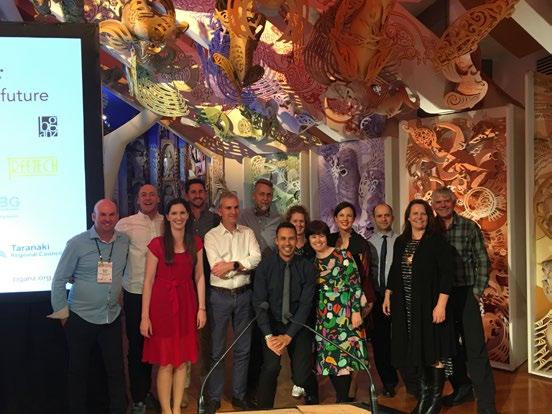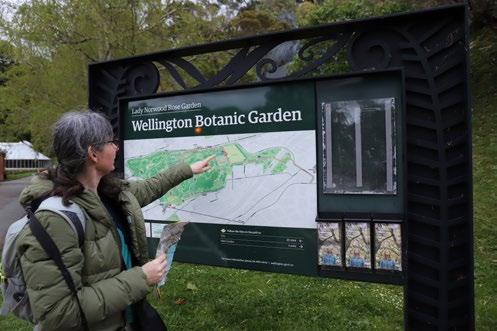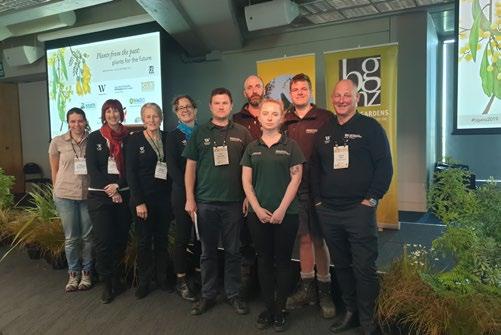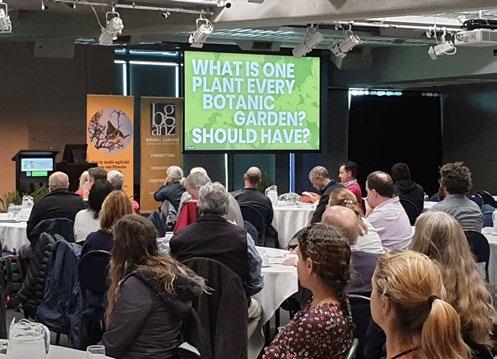
4 minute read
9th BGANZ Congress – Wellington, New Zealand
from THE BOTANIC GARDENer
by BGANZ
A few personal perspectives from the congress
Janet O’Hehir, Camperdown Botanic Gardens and Arboretum
Advertisement
One of the defining characteristics of many New Zealand plants is divaricating foliage. Wikipedia tells us that divaricate is a botanical term meaning spreading at a wide angle. Plants are said to be divaricating when their growth form is such that each internode diverges widely from the previous internode producing an often tightly interlaced shrub or small tree. The branches and twigs shoot off in different directions, but they make an interlaced whole, and their structure is part of their mechanism for survival. You can see where this is going. I’m seeing a parallel with BGANZ and the botanic gardens network.
My take-aways from the 2019 bi-annual congress in Wellington were about networks, diversity and inclusion. Diversity in the styles, growing conditions and ages of gardens, in vegetation and collections, in engagement strategies and activities, and even in the presentation styles of speakers. Who wasn’t captivated by Robbie Blackhall-Miles and his intense pauses, or engaged by Greg Bourke’s determination to bring the conversation back to carnivorous plants, and Nick Waipara’s fluency in naming Maori places and projects (which was a bit startling to the Aussie ear, with ‘wh’ sounds pronounced as ‘f’)?
The Australian contingent could not help but be inspired by the inclusion of the Maori presence, from the wonderful performance by singers from a Maori school at the reception in Wellington Botanic Garden’s conservatory, to the mihi whakatau, the welcome speech, and frequent references to people, places, projects and plant names in the Maori language. Organisers of the 2021 congress will no doubt be considering what they have learned and in what ways they can similarly embrace Melbourne’s indigenous peoples and cultural heritage, as well as acknowledging the city’s growing multiculturalism.
I am always struck by the inclusivity I find at BGANZ events. From internationally acknowledged sites of cultural significance like Kew Gardens, and heritage gardens in capital cities, like Sydney, Melbourne and Dunedin, to more contemporary gardens like Cranbourne and Auckland, right down to new gardens where volunteers lead projects aimed at showcasing their local indigenous plants or providing a special amenity for their own residents and visitors, everyone has an opportunity to participate. Diversity is an important principle of ecological sustainability. It is also an important principle of organisational sustainability, resilience and success. It is pleasing when you see scientists, horticulturists, educators and others engaged in the activities of botanic gardens embracing diversity in their sector.
The congress is an occasion for networking. I saw friendships started and strengthened, invitations issued and social media contacts exchanged. Clare Hart and Peter Symes’ presentation about planning for climate change highlighted the new international climate change alliance, which aims to bring together people from botanic gardens around the world to share knowledge, commitment and experiences to respond to a crucial global issue. It started with individuals meeting and having conversations.
Views were exchanged about the quality of the food (excellent), the messages taken from different presentations, and the value of the field trips. You know a conference field trip has hit the spot when you hear participants saying the end-of-the-day stop at a micro-brewery for craft beers and pizza could have been omitted so more time could have been spent exploring the intriguing indigenous plants at Otari–Wiltons Bush.
I looked around the gate lounge at Wellington airport as we waited for our boarding call. Peter and Chris were going over the list of who had and hadn’t signed up so far for the climate change alliance, Virginia was chatting about visiting the Garden for the Future at Bendigo, Tim was searching online for a book about the epiphytic plants of New Zealand, and John was looking up from his laptop every few seconds to relate fascinating facts about the incidence of heteroblasty in the New Zealand flora.
I believe the 2019 congress was a great success.

New Zealand and Australian BGANZ Members at the congress dinner, in the fantastic Te Papa Museum, the venue for the Congress and the final dinner.
Photo gallery – out and about at the 9th BGANZ Congress
Andrea Dennis, Maranoa Gardens, finding her way around Wellington Botanic Gardens.


BGANZ Members studying the plants in the Wellington Botanic Gardens Greenhouse.
John Sandham, (fmr BGANZ President) Botanic Gardens South Australia, and Paul Birch, Maranoa Garden, participating in congress closing event celebrations.


From left to right: Karin Van der Walt, Clare Shearman, Marion Saunders, Celeste Derozier, Finn Michalak, Andrew Fawcet, Abbey Pruden, Cory Meister, David Sole. Wellington Botanic Gardens staff hosted a wonderful Congress.
BGANZ Congress continually challenged and provided outstanding presentations for all members


Jimmy Turner, Royal Botanic Garden Sydney, provoking thought in his presentation.










